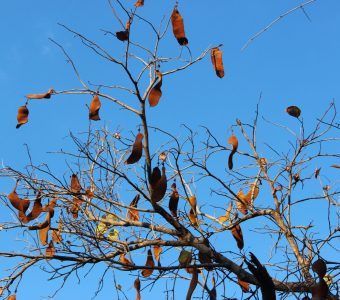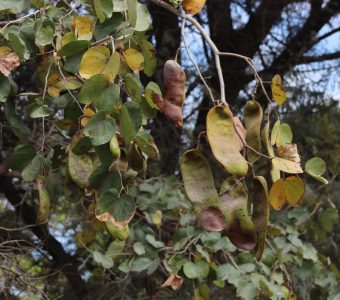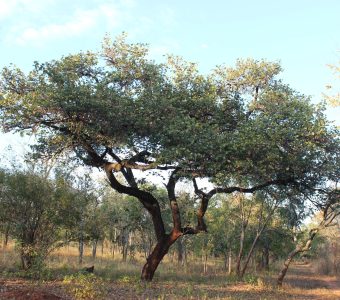


Botanical Name: Philostigma thonningii Schumach.
Synonym: Bauhinia thonningii (Schumach.) Milne-Redh.
Common Name: Monkey Bread, Camel’s Foot
Plant Family: Caesalpinaceae
Origin: Africa
References: Coates Palgrave p.337, Storrs 1 p.81-82, Venter p.46. S.A. No. 209, Zimb. No. 265
Description: A small to medium sized rounded evergreen tree with a roundish open crown. B. thonningii resembles a stouter version of B. petersiana but is a tree and has leaves between twice or thrice as big with the nerves very prominent on the underside. It occurs in woodland and grassland.
Features of Particular Interest: Has inconspicuous white flowers with short wrinkled petals. The fruit is a large, solid, reddish-brown, fibrous, woody pod. It is non-splitting.
Height and Spread: 3 – 5 m but reaching 10m under ideal conditions, spread 4-8m.
Periods of Interest:
Leaf: All year round.
Flowering: July to January.
Fruiting: October to July.
Cultivation
Soil and Moisture: Prefers sandy soils.
Aspect: Prefers open sun.
Hardiness: Tender to frost, but can withstand drought.
Maintenance and Pruning: Not normally required.
Propagation: Grows easily from seed. Open pods with hammer, soak seeds overnight and plant in sandy medium. Taproot develops fast so plants must be planted out soon.
Problems and Drawbacks: A slow grower – 600mm a year.
Use and Associated Planting: The green fruits of B. thonningii are a substitute for soap. Bark is used for making string and the pods are eaten by game and cattle. Pods and seeds widely used in local medicine. B. thonningii can be used as a specimen tree in frost free gardens, with an interesting growth habit and large bi-lobed leaves and broad pods which add uniqueness. Good for firewood. Roots are non aggressive and can be planted near paving.
Notes: A protected tree in South Africa.
